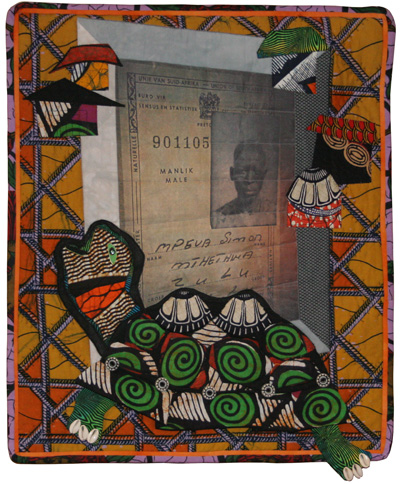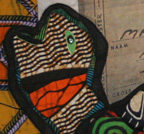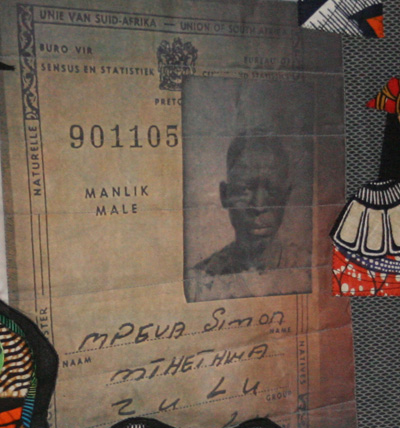
QUILT INDEX RECORD
12-8-5012
Who documented this quilt?
Michigan Quilt Project; Michigan State University Museum Collection; Quilts and Human Rights
Where are the records for this quilt housed?
Michigan State University Museum
Michigan Quilt Project Number:
08.0002
If this quilt is owned by a museum, enter the accession number:
2008:155.1
Object label:
She Carries Her House
Chris Worland
East Lansing, Ingham County, Michigan
2000
Collection of Michigan State University Museum acc.#2006:155.1
Essay:
In the summer of 1999, I traveled to South Africa. The South Africans I met were very welcoming and friendly. When they began to tell stories of living through apartheid, I was shocked by the level of violence and coercion and dismayed by my ignorance of that horrible period in South Africa's history. This quilt is my response to that trip. The pass book photo is from one I took at the Kwa Muthle Museum in Durban, [a museum devoted to telling the story of living under apartheid]. The turtle was inspired by a woodcut by Carina Minnar. The turtle represents the rights granted in the 13th clause in the South African Bill of Rights. Like the turtle who carries her house with her, South Africans are now free to reside where they please.
Under apartheid, all non-white South Africans were subjected to strict rules of segregation and limits of their rights. All non-whites had to carry a pass book which included their photograph and a statement of whether they were Indian, black, or colored (mixed race). Failure to produce a pass book on demand often led to harassment, torture, and imprisonment. The system of pass laws was finally repealed in South Africa in 1986.
Quilt's title:
She Carries Her House
Subject of the quilt:
anti-apartheid
When was the form filled out?
2/7/2008
Quilt top made by:
Worland, Chris
Quilted by:
Worland, Chris
If you are the quilt owner, how did you acquire this quilt?
Made the quilt
Where the quilt was made, city:
East Lansing
Where the quilt was made, county:
Ingham
Where the quilt was made, state:
Michigan (MI)
Where the quilt was made, country:
United States
Time period:
2000-2025
When was the quilt finished?
2000
Why was the quilt made?
Art or personal expression; Commemorative
Quilt is presently used as:
Artwork/wall hanging; Study or teaching aid
Quiltmaker's gender:
Female
Quiltmaker's city:
East Lansing
Quiltmaker's county:
Ingham
Quiltmaker's state:
Michigan (MI)
Quiltmaker's country:
United States
Quiltmaker's maiden name:
Worland
Quiltmaker's birth date:
7/21/1944
In which kind of environment did the quiltmaker live?
Urban
Quiltmaker's ethnic background/tribal affiliation:
Caucasian
Quiltmaker's educational background:
Masters degree
Quiltmaker's occupation:
Teacher
Quiltmaker's father's name:
Worland, Donovan
Quiltmaker's mother's name:
Stout, Immogene
Quiltmaker's mother's ethnic/tribal background:
caucasian
Quiltmaker's spouse's/spouses' and/or partner's/partners' occupation:
Professor
Number of children:
2
How many of the quiltmaker's children were girls?
1
How many of the quiltmaker's children were boys?
1
How did the quiltmaker learn to quilt?
From Class; Self-Taught
When did the quiltmaker learn to quilt?
Age 30-39
Estimated number of quilts made by this quiltmaker:
20-50 quilts
Does/did the quiltmaker sell quilts?
yes
Does/did the quiltmaker teach quilting?
yes
Does/did the quiltmaker belong to a group? Name of the group?
Greater Lansing Quilt Guild, Ann Arbor Quilt Guild
What are the main activities of the group?
speakers, show and tell
This is a:
Finished quilt
How wide is the quilt?
20 1/4"
How long is the quilt?
24"
Shape of edge:
Straight
Shape of corners:
Rounded
What color is the quilt?
Beige or Tan; Black; Blue; Green; Orange; White
Quilt's condition:
Excellent/like new
What is inscribed on the quilt?
MPEVA Simon Mthethwa
Method used to make the inscription:
Printed in the fabric
Location of inscription:
on block
Describe the quilt's layout:
Pictorial
Number of quilt blocks:
1
Medallion size:
20 1/4" x 24"
Arrangement of quilt blocks:
Straight
Fiber types used to make the quilt top:
Cotton
Describe the fibers or fabrics in the quilt top:
African prints
Piecing techniques used to make the quilt top:
Machine Piecing
Can you feel or see paper on the quilt that was used as a construction aid?
no
Applique techniques used to make the quilt top:
Machine Applique
Embellishment techniques used to make the quilt top:
Photography/ photo transfer
Materials used to make the back:
Cotton
Materials used in the quilt binding:
Cotton
Fabric structure of the binding:
Plain weave
How is the binding made?
Straight grain
How wide is the binding (measure on the top only)?
The binding is two strips; 1/2" of purple abstract, 1/4" of cheddar orange solid sewn lengthwise to create the effect of piping.
What kind of filling is used in the quilt?
Cannot tell
How thick is the quilt?
Thin (Less than 3/16?)
How are the layers held together?
Hand quilting
Quilting designs used, overall motifs:
In-the-ditch
Features or notes about the quilt's appearance, materials, or construction:
"In the summer of 1999, I traveled to South Africa. The South Africans I met were very welcoming and friendly. When they began to tell stories of living through apartheid, I was shocked by the level of violence and coercion and dismayed by my ignorance of that horrible period in South Africa's history. This quilt is my response to that trip. The pass book photo is from one I took at the Kwa Muthle Museum in Durban, [a museum devoted to telling the story of living under apartheid]. The turtle was inspired by a woodcut by Carina Minnar. The turtle represents the rights granted in the 13th clause in the South African Bill of Rights. Like the turtle who carries her house with her, South Africans are now free to reside where they please." Under apartheid, all non-white South Africans were subjected to strict rules of segregation and limits of their rights. All non-whites had to carry a pass book which included their photograph and a statement of whether they were Indian, black, or colored (mixed race). Failure to produce a pass book on demand often led to harassment, torture, and imprisonment. The system of pass laws was finally repealed in South Africa in 1986.
Where did the maker find their pattern?
Original to maker
Exhibitions where this quilt was displayed:
Quilts and Human Rights, Michigan State University Museum, January 15 - August 24, 2008
Person filling out this form is:
Quiltmaker
Ownership of this quilt is:
Private
Quilt owner's name:
Chris Worland
Quilt owner's city:
East Lansing
Quilt owner's county:
Ingham
Quilt owner's state:
Michigan (MI)
Quilt owner's country:
United States
How was this quilt acquired?
Made by owner
Details
Access and copyright information:
Restricted
How did the quiltmaker participate in the creation of the quilt?
Made entire quilt
If the source helped design the quilt, describe their input:
Designed the pattern
The quilt was made to be used for:
Artwork/wall hanging
Who photographed this quilt?
Pearl Yee Wong
Copyright holder:
Michigan State University Museum
Cite this Quilt
Worland, Chri. She Carries Her House. 2000. From Michigan State University Museum, Michigan Quilt Project; Michigan State University Museum Collection; Quilts and Human Rights. Published in The Quilt Index, https://quiltindex.org/view/?type=fullrec&kid=12-8-5012. Accessed: 04/20/24
-
Gallery
Themes for Educators: Animals
Sikarskie, Amanda Grace
-
Exhibit
Quilts and Human Rights
MacDowell, Marsha; Worrall, Mary; Swanson, Lynne
-
Gallery
Themes for Educators: Nelson Mandela a...
Sikarskie, Amanda Grace

